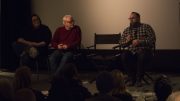The building of the new Blue Bombers stadium on campus has brought with it a circus of controversy surrounding traffic control and the availability of adequate parking spots.
Due to the potential people and traffic a stadium will bring, an open house was held by Crestwin Properties, who are heading the project, on Oct. 7 in the basement of the Fort Garry Evangelical Mennonite Church.
This was the second of two open houses organized by Creswin to communicate with the residents of Fort Richmond about their concerns, and showcase what solutions they have planned to address them. The first was held Sept. 30 at the Winnipeg Mennonite Elementary School.
“We’ve hired professionals and worked with the city to develop some notions and concepts, and we’re here tonight to get some feedback from the Fort Richmond residents as to what they think of what’s being proposed,” said Crestwin president Dan Edwards.
“[ . . . ] You have to engage and look at how the cars are going to get in and leave. What are the bus requirements and the active transportation requirements?”
Considering there are 33,000 seats for games, and potentially even larger draws for concerts, questions were raised by residents about where all the attendees will park.
Edwards was confident that with the proposed solutions this would not be a problem.
“We’ve got in excess of 5,000 stalls at the university. If you look at three people per car on average, that takes 15,000. We’ve got the bus programs. There will be people walking. [ . . . ] We’re very optimistic that this is going to be a very good plan,” explained Edwards.
However, Louise May, a city councillor candidate for the St. Norbert ward, felt the plan is poorly conceived and that there still isn’t a realistic plan for parking on game days.
“Number one, it’s completely relying on a rapid transit program that’s not in place, and there is no funding for it [ . . . ],” said May.
“So far we are still only addressing the crowd scale of the games, [ . . . ] where as the size of the crowd for the concerts is going to be 60,000, so then where is the plan for the 60,000?”
May also brought up the issue of the potential for mischief to arise in quiet communities, with such large and possibly rowdy crowds moving through them.
“If you’re looking at a parking radius that extends well into the residential communities, then that means people are walking back-and-forth, and there is sort of stereotype of littering and boisterousness and vandalism and party mode that people in a very quiet community are very, very concerned about,” said May.
Plans are also being made to discourage stadium-goers from parking in residential communities, which are centred on the concept of access control points and coupled with parking restrictions.
The access control points will be located at points of entry into the surrounding neighbourhoods close to the stadium in the south end of the city.
Sergeant Kevin Cisaroski of the Winnipeg Police Service traffic division explained that the city is looking at putting three officers at three access control points in the south end.
“The reason for the access control points is informational. The police aren’t going to be doing any enforcement at these locations [ . . . ],” said Cisaroski
Access control points, along with parking restrictions, will only be in effect on days designated as event days.
On such days when parking restrictions are in place, if stadium-goers decide to ignore access control point warnings and park in residential areas, they will face being ticketed and/or towed.
To ensure that residents are not affected, they will be provided with permits and encouraged to display them on their vehicles on event days.
“If it’s a game person, then we will tell them don’t bother parking here because your car won’t be here. [ . . . ] If you’re a resident it will be a reminder to put your permit on your vehicle and [ensure] it’s visible so you don’t get a ticket or towed,” said Cisaroski, explaining the access control points further.
One concern many residents have about the access control points and police assistance is that it might not be effective.
“A lot of these things could change, so you say we’ll have an officer at the corner but what if the next year the police decide to cut costs? What if they say it’s working fine, we’re not going to put that there anymore?” said May.
May suggested putting in place by-laws specific to the stadium so that there would be a legal, contractual obligation “to satisfy the needs of the community.”
Some of the proposed changes will also affect students on the Fort Garry campus.
On event days there are a number of proposed road closures immediately around the new stadium. University Crescent will be closed between Dysart and Dafoe Road.
Half of Chancellor Matheson Road will also be closed, starting from where it meets University Crescent.
In addition, many parking areas on campus are going to be reallocated as “Event Parking” and reserved for stadium-goers.
As a result of the road closures, students will also likely be faced with modified bus routes.
Some attendees were just as optimistic as Edwards and left the event feeling their concerns had been properly addressed.
Fort Richmond resident Lynn Reimer liked some aspects of Crestwin’s plan, but had problems with the proposed restriction of traffic.
“When I first heard that, I remembered being at Checkpoint Charlie at the Berlin Wall [ . . . ] but the police have addressed the fact that they aren’t going to be restricting any traffic. They will just be informing people; that sounds a whole lot better already,” said Reimer.
The stadium is slated to be up and running for the 2012 season kick-off




